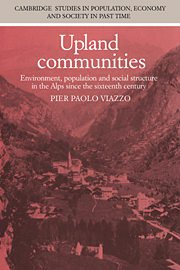 Upland Communities
Upland Communities Book contents
- Frontmatter
- Contents
- List of illustrations
- List of tables
- List of abbreviations
- Acknowledgements
- Introduction: anthropology, historical demography and the study of mountain societies
- 1 Environment, population and social structure: the Alpine village as an ecosystem
- 2 Open systems, open questions
- 3 Anthropologists in the Alps
- 4 The changing demography of Alpine communities
- 5 The traditional economy and its demise
- 6 The causes and consequences of Alpine emigration
- 7 The wealth from the earth: mining and immigration
- 8 Population, resources and homeostatic regulation
- 9 The domestic domain
- 10 Upland communities
- A summary of conclusions
- Bibliography
- Index
8 - Population, resources and homeostatic regulation
Published online by Cambridge University Press: 13 October 2009
- Frontmatter
- Contents
- List of illustrations
- List of tables
- List of abbreviations
- Acknowledgements
- Introduction: anthropology, historical demography and the study of mountain societies
- 1 Environment, population and social structure: the Alpine village as an ecosystem
- 2 Open systems, open questions
- 3 Anthropologists in the Alps
- 4 The changing demography of Alpine communities
- 5 The traditional economy and its demise
- 6 The causes and consequences of Alpine emigration
- 7 The wealth from the earth: mining and immigration
- 8 Population, resources and homeostatic regulation
- 9 The domestic domain
- 10 Upland communities
- A summary of conclusions
- Bibliography
- Index
Summary
The changing balance of population and resource
The discussion of Alpine migration patterns contained in the last two chapters has shown that many widespread notions concerning both emigration and immigration are in need of major modification, and that a number of important problems must be considered more carefully than has been the case so far. One such problem is whether permanent emigration actually played a more decisive role than other coping devices used by Alpine populations to strike a viable balance with their resources. The best way of tackling this problem is to verify whether upland communities could approach a homeostatic condition in which mechanisms lowering fertility kept natural increase within tolerable limits, thereby reducing the significance of permanent emigration as a safety valve. Some evidence has already been presented in Chapter 6. But it is now time to examine in a more comprehensive manner both this question and, more generally, the Malthusian model outlined in Chapter 2.
As we have seen, the foundation of Malthus's argument is that in mountain areas the ceiling of resources is easily reached, all the more quickly when for some reason mortality sharply declines, as had apparently been the case in the Swiss Alps in the course of the eighteenth century. It is therefore in the mountains that the check o Indeed, the figures collected by Muret on Leysin and other mountainous parishes of Canton Vaud offered an impressive example of how effective the check of nuptiality could be as a homeostatic mechanism. f nuptiality should be expected ‘to prevail to an unusual extent’. Indeed, the figures collected by Muret on Leysin and other mountainous parishes of Canton Vaud offered an impressive example of how effective the check of nuptiality could be as a homeostatic mechanism.
- Type
- Chapter
- Information
- Upland CommunitiesEnvironment, Population and Social Structure in the Alps since the Sixteenth Century, pp. 178 - 223Publisher: Cambridge University PressPrint publication year: 1989
